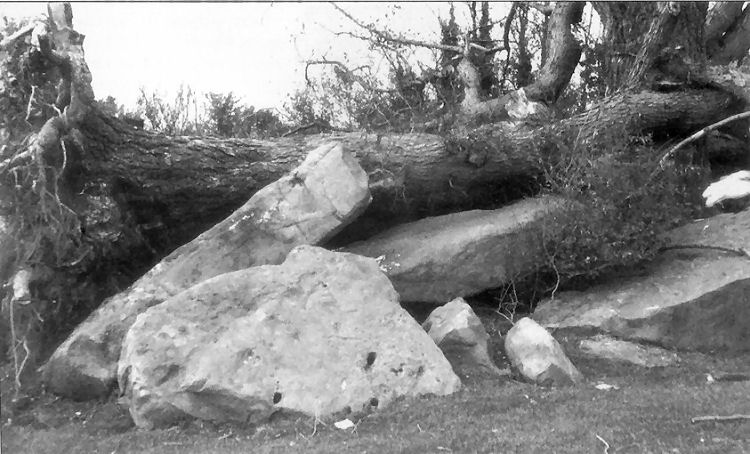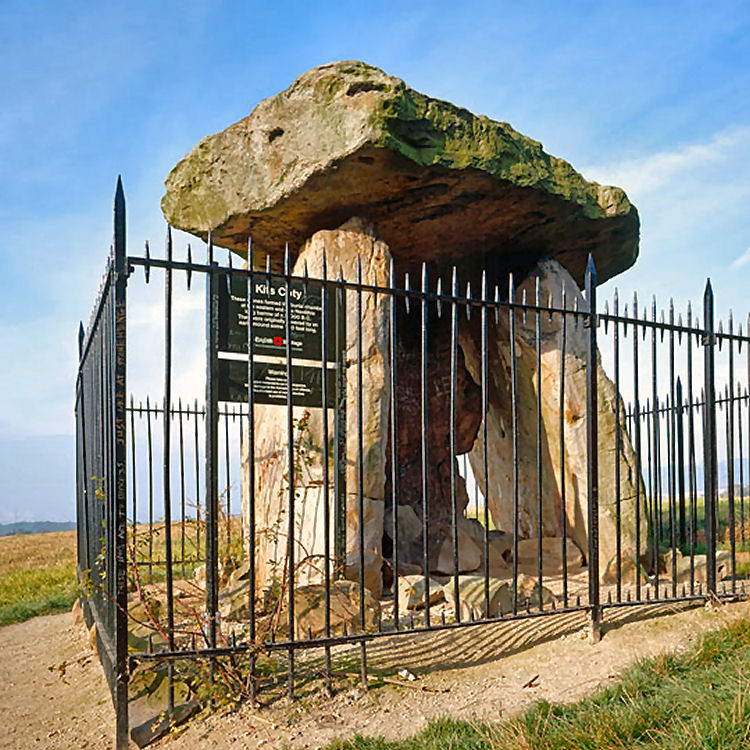|
Boxley Hill
Blue Bell Hill

Above photo posted by Philippa Hoad on Facebook showing a photo of
Little Kits Coty (the Countless Stones) 1987 when the Elm that had
survived the onslaught of 1970 Dutch Elm disease came down in the storm. |
Only references found of this Inn at present is from the sale of wood in
1816 and of its own sale in 1827.
Said to have been close to the "Lower
Bell Inn." Obviously an inn situated near to the standing stones
titles Kits Coty House, which is stated to have been "the
Burial Place of Catigern," and to "Many old historic sites, Sacred to Legend
and Poesy."
|
Kentish Gazette, Friday 24 May 1816.
Freehold Woodland. Chatham.
To be sold by auction by Charles Larkin. At the "Kits Coty House,"
Bluebell Hill, between Rochester and Maidstone on Friday June 21, 1816,
precisely at 12 o'clock, in 6 lots (unless previously disposed of by
private contract) upwards of 60 acres of excellent freehold wood, called
Lord's Wood (excepting about 2 acres which is in Drew Hill Wood) situate
near Gibraltar Farm in the parish of Chatham, belonging to and in the
occupation of John Fowle esq.
The lots of extremely well situated midway between the great populations
of the three towns and Maidstone, approached by good roads and are
singularly well tillered, having been preserved and felled by the
proprietor with the greatest care and attention.
To the proprietors of the other parts of Lords Wood, this offer is
highly interesting, inasmuch as it affords them an opportunity of
attaching to their respective Estates the Lots contiguous there to,
which cannot fail proving a most desirable acquisition.
Printed particulars and conditions of sale, are prepairing and may be
had at the principal Inns, Rochester, Chatham, Sittingbourne and
Maidstone, at "Kits Coty House," and of Charles Larkin, Land Surveyor
and Appraiser, City Repository, Rochester, where a sketch of the Lots
may be seen, and who is duly authorised to treat for the Sale, either
separate or together by Private Contract.
John Fryar of Bredhurst will show the Lots, and a sketch pointing them
out, may be seen at "Kits Coty House."
|
|
From the Maidstone Gazette and West Kent Courier, 25 September, 1827.
To be let.
Kits Coty House Inn, situated on the declivity of Boxley Hill, leading
from Rochester to Maidstone.
Immediate possession may be had.
Rent moderate.
The appraisement will not exceed £160. Apply to Mr Thomas
Homewood, Appraiser, Maidstone.
|
|
From the Maidstone Gazette and West Kent Courier, 7 September, 1830.
Public house to be let. With immediate possession.
Kitts Coty House, delightfully situated on the the declivity of Boxley
Hill, on the Turnpike Road leading from Rochester to Maidstone. The
furniture &c. about £300 must be taken at a fair valuation, half of
which may remain on proper security being given if required.
Apply to Mr. Thomas Homewood, Appraiser and Auctioneer, Gabriel's Hill,
Maidstone, or to Mr. Alexander on the premises.
Rent very moderate.
|
|
Maidstone Journal and Kentish Advertiser, Tuesday 26 November 1844.
Whereas, a petition of John Robert Alexander, formerly of the "Lower
Bell Inn," Aylesford, Kent, licensed victualler, then of "Kits Cotty
House," Aylesford, aforesaid, out of business, then of Moat Road,
Maidstone Kent, out of business, and then of the "White Hart" public
house, Chatham, Kent, licence victualler, and late of the same place,
waiter, having been filed in the Court of Bankruptcy and the Interim
Order for Protection from Process having been given to the said John
Robert Alexander, under the provisions of the statute in the case made
and provided, the said John Robert Alexander is hereby required to
appear in Court before Edward Holroyd, Esq., the Commissioners acting in
the matter of the said Petition, on the 12th day of December next, at 11
o'clock in the forenoon precisely, at the Court of Bankruptcy,
Basinghall Street, London, for the purpose of his first examination
touching his Debts, Estate, and Effects, and to be further dealt with
accordingly to the provision of the said estate; and notice is hereby
given, that the choice of Assignees is to take place at the time so
appointed.
All person's indebted to the said John Robert Alexander, or that have
any of his effects, are not to pay or deliver the same but to Mr. James
Foster Groom, No. 12, Abchurch Lane, Lombard Street, the Official
Assignee, nominated in that behalf by the Commissioner acting in the
matter of the petition.
James Johnstone. Messenger.
|
|
From the Maidstone Telegraph, Rochester and Chatham Gazette, 25 May 1861.
One of the most remarkable monuments of antiquity "Kit's Coty House" is
situated on the brow of the hill, a little more than a mile
from the town, above which various opinions have been expressed, but
none appear to be more truthful than those in a recent work
"Round about Kits Coty House," where it is an established fact that it
is a druidical structure and an altar where the Druids sang
"Songs in praise of the ancient warriors," and not Catigern's Tomb as it
has been stated.
|
|
Information taken from
http://www.english-heritage.org.uk 17 December 2017.
HISTORY OF KIT’S COTY HOUSE AND LITTLE KIT’S COTY HOUSE.
Kit’s Coty House and Little Kit’s Coty House are the remains of two
megalithic long barrows standing in open fields. The sites offer fine long
views across the North Downs and Medway Valley.
The burial chamber at Kits Coty House, surrounded by a protective black iron
railing enclosure.
NEOLITHIC BURIAL RITES
The origin of the name Kit’s Coty is not known. For many years it was
thought to be a corruption of Catigern, the name of a British prince slain
in single combat with the Saxon Horsa in a battle at Aylesford in AD 455 at
which the Britons were victorious. The monuments were therefore assumed to
be a memorial to him.
There is no evidence to support this suggestion and the barrows predate this
event by thousands of years.
Long barrows were constructed during the early Neolithic period, between
about 4000 and 3000 BC. They represent the burial places of the earliest
farming communities in Britain, and are among the oldest surviving
prehistoric monuments.
Long barrows appear to have been used for communal burial – often with only
parts of the human remains being selected for interment – and it is probable
that they acted as important ritual sites for local communities over a
considerable period of time.
KIT'S COTY HOUSE.

Above photo showing the burial chamber at Kits Coty House.
The most distinctive surviving feature of this monument is the H-shaped
arrangement of three large slabs of sarsen stone (a fine-grained,
crystalline sandstone) capped by a further slab, which formed the main
burial chamber of the barrow.
The stones were originally buried at the eastern end of a long earthen
mound, of which only traces survive.
Earth and chalk for the construction of
this mound was quarried from flanking ditches to the north and south and
these can be seen clearly on aerial photographs of the site.
The mound was surrounded by a retaining kerb of sarsens, some of which may
lie buried in the field.
LITTLE KIT'S COTY HOUSE.

Little Kits Coty House viewed from the south east.
Little Kit’s Coty House, also known as the Countless Stones, is a group of
about 20 sarsen stones in a tight cluster. They represent the remains of a
burial mound which was seriously damaged in 1690, before any reliable
records were made.
A letter written at the time describes ‘13 or 14 great stones, 7 standing
all covered with one large stone’. It is likely that this burial chamber was
originally covered with a substantial mound, as at Kit’s Coty House.
In the 1880s, as concern mounted about damage to ancient monuments, Kit’s
Coty House and Little Kit’s Coty House were among the first to be protected
by the state, on the advice of General Augustus Henry Lane Fox Pitt-Rivers,
the first Inspector of Ancient Monuments. Railings were erected around the
stones to prevent vandalism.
|
LICENSEE LIST
ALEXANDER John Robert 1830+

|


